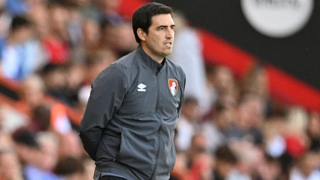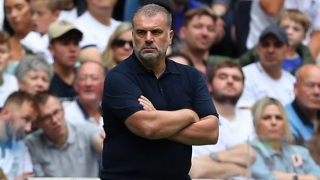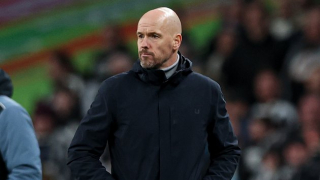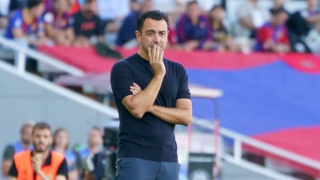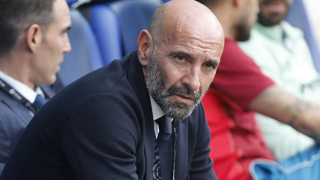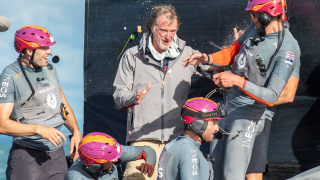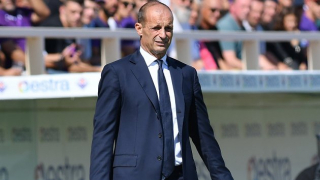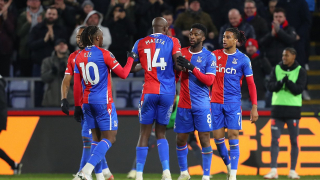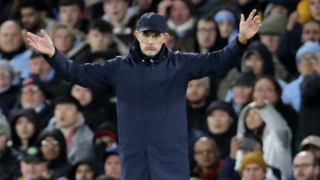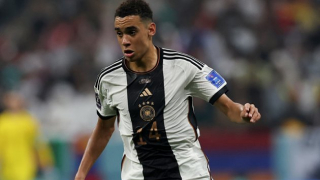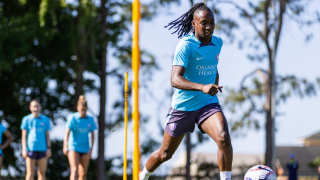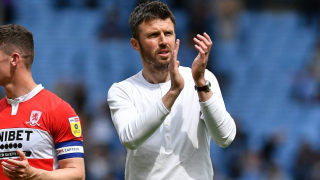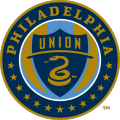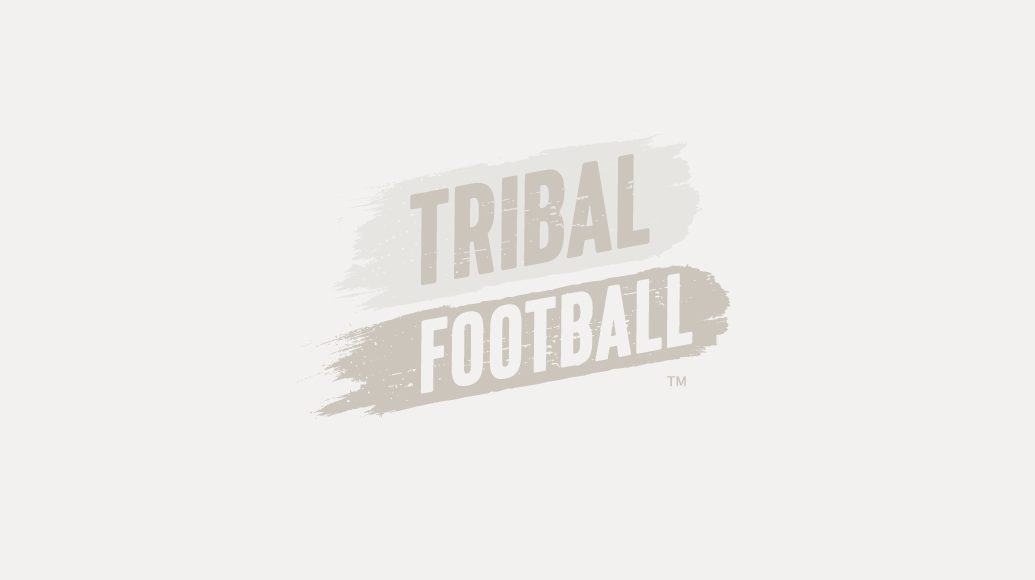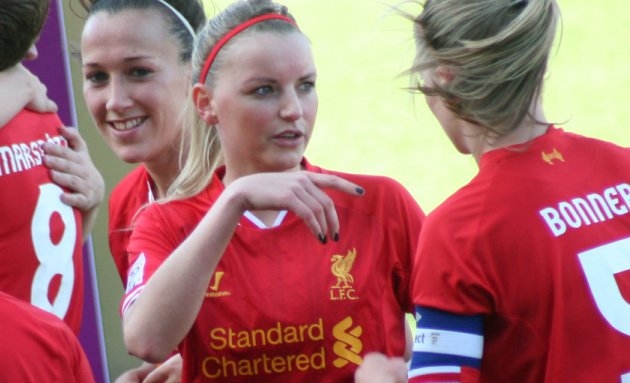This week, we present news on the first eight teams that are joining the USL's Super League for the 2024-25 season, along with the shocking revelation that they are bidding on Division I Professional Status from U.S. Soccer, rather than Division 2.
TribalFootball.com talked exclusively with one of the owners of the new Spokane, Washington Super League franchise about his Super League franchise and plans to grow the women's game in Eastern Washington and the outlying region. We also interviewed USL Super League Commissioner Amanda Vandervort in person last week as well. We also look at the other professional leagues for women that are exploring or planning for Division 2 or 3 status in the years to come, and finish by looking at the new USL Girl's Academy launch.
USL Super League Names First Eight Cities
On May 16, the United Soccer League (USL)—which launched its amateur W-League last year, for which its previous incarnation folded in 2015 after 21 seasons—announced its first eight franchises for its professional Super League for the 2024-25 season while also pushing back their intended launch from this year. The Super League will petition U.S. Soccer for Division 1 status—the same as the NWSL has—when previously it was looking to be a Division 2 league (a minor league below the majors in North American parlance). The Super League had previously announced that they would run a fall-to-spring schedule, which differs from North American football (soccer) tradition, which usually run a spring-to-fall season because of severe winter weather in northern portions of the U.S. and in Canada, where MLS has three franchises. Eight teams were announced, most in warm weather environments, with two in Arizona:
- Charlotte, North Carolina
- Dallas/Fort Worth, Texas
- Lexington, Kentucky
- Phoenix, Arizona
- Spokane, Washington
- Tampa Bay, Florida
- Tucson, Arizona
- Washington D.C./suburban Loudoun United in Leesburg, Virginia
The league wants to launch its first campaign with 10-12 teams, and other possibilities include:
- Chattanooga, Tennessee (which currently has the Chattanooga Red-Wolves in the W-League)
- Indianapolis, Indiana (which currently has a W-League team, Indy 11, and a USL Championship men's side)
- Jacksonville, Florida
- Madison, Wisconsin, which has Forward Madison in USL League 1
- Oakland, California (which currently has the W-League Oakland Soul Women)
Of the eight inaugural sides, all except for Dallas currently have a USL men's Championship (Division 2), League One (Division 3) or League Two (Summer Amateur League or Division 4,) franchise—or will next year in the case of Spokane. (League Two, formerly the Premier Development League or PDL, allows high school and college players to return to their school teams and not lose their collegiate amateur status). Interestingly, only three of the 44 W-League franchises from year one in 2022 are moving up—Lexington SC, Tampa Bay United SC, and Charolotte has the W-League Charlotte Independence Women (though they could, in theory, run teams in both leagues). For the D.C./Northern Virginia area, the six Mid-Atlantic Division's six teams are in the Metro-D.C. area. We present a quick recap of the eight initial Super League markets and their other USL affiliations (if they have one):
- Charlotte—League 1.
- Dallas/Fort Worth—the only franchise that does not have a current USL franchise.
- Lexington, Kentucky—In its first season in League 1 in 2023, Lexington SC is playing at Georgetown College's 5,000-seat football stadium. It is developing a training complex and is working on building a 6,500-seat stadium for the two pro teams.
- Phoenix—The Phoenix Rising (USL Championship) franchise (which has been in the league since 2013, though under different names and ownership groups) has 4,000 girls playing in its youth program. Rising President Bobby Dulle said that, over the past 3-4 years, the club has seen around 100 women go on to college teams around the nation. He added: "Thanks to this announcement [of the Super League], those [academy player] girls will now have world-class role models close to home, and far more job opportunities, should they choose to pursue a career in soccer." Phoenix Rising recently opened a 10,000-seat modular stadium just north of Phoenix Sky Harbor International Airport, which is also on the area's light rail line and convenient for Phoenix, Scottsdale and Tempe residents, the latter being where Arizona State University is located and is only a few minutes away. Rising does not have a current women's semi-pro team but the area has FC Arizona in the UWS and Phoenix Del Sol, Arizona Arsenal and Utah Royals FC AZ—which has long run an academy in the area—in the WPSL. ASU has a NCAA Division I college team as does Grand Canyon University on the west side of the city, Northern Arizona University in Flagstaff and the University of Arizona in Tucson, which could be a viable source for future professional players for the franchise.
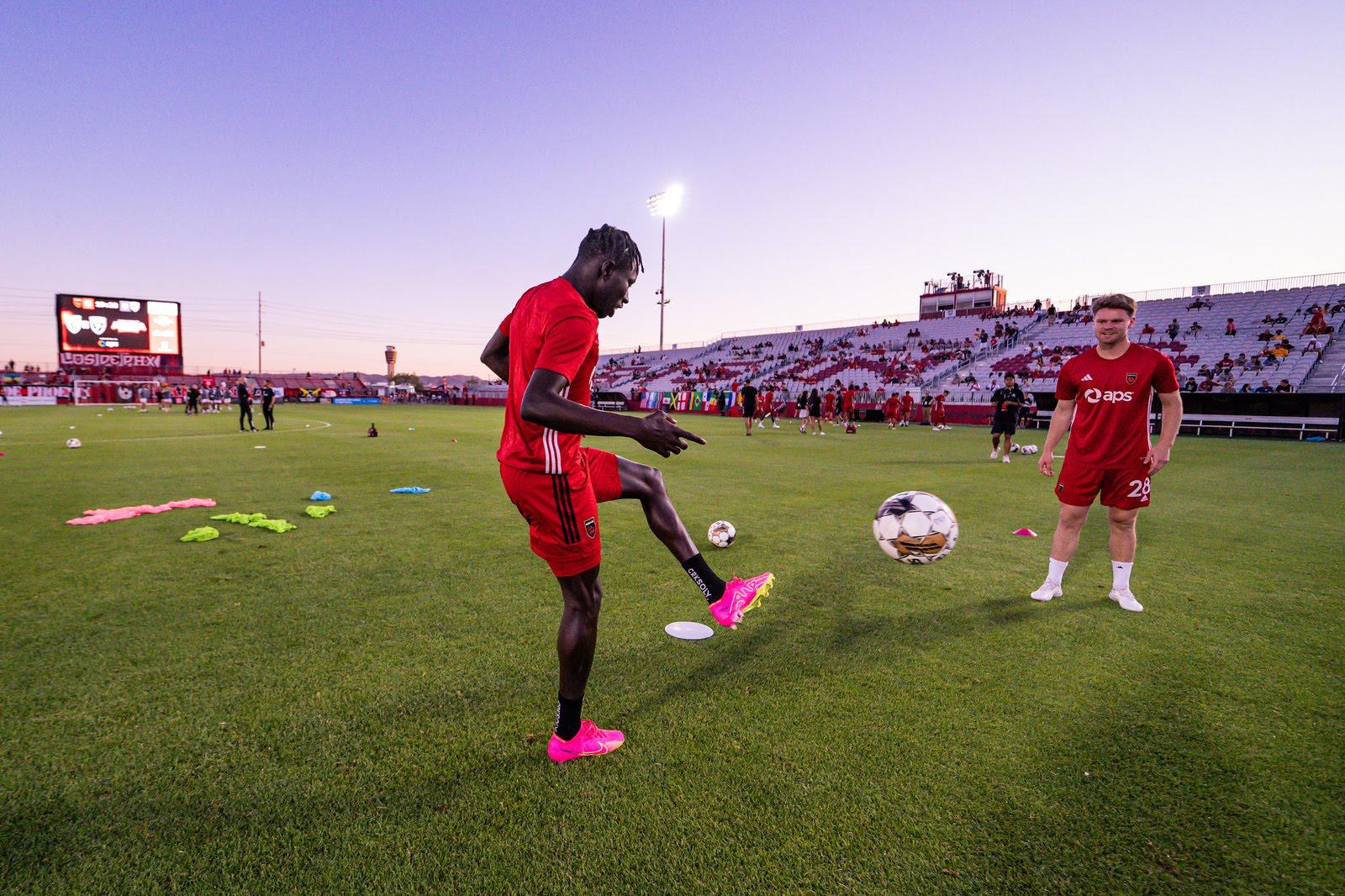
Phoenix Rising players warm up before a game on May 26 against the Las Vegas Lights, with the Phoenix Sky Harbor airport just south of the field, to the left of the scoreboard. Rising FC is adding a USL Super League Women's franchise to the 10,000-seat stadium for the inaugural 2024-25 season. Photo by Arianna Grainey, courtesy Phoenix Rising FC
- Spokane, Washington—The city will enter USL League One next year and are currently building a 5,500-seat downtown stadium. TribalFootball.com talked exclusively to team owner Ryan Harnetiaux (see more below), who with his wife Katie is leading the effort to bring the Super League team as well as W League and League One franchises to the city for next year. Gonzaga University Bulldogs women's side has won 54 games and tied 1 of their 86 matches since 2018 (including a shortened season in 2020 due to COVID) in a very competitive West Coast Conference, including the University of Portland, Loyola Marymount and Santa Clara. This year, GU sent Sophia Braun to Club Leon of the Liga MX Femenil and she is expected to play in the Women's World Cup this summer for Argentina. Gonzaga U. holds the record for the largest women's football crowd in the city, when 1,234 saw their game last year against the University of Oregon (a 2-2 tie at Luger Field). Traditionally, WPSL teams in the city in the past—the Spokane Shine and Black Widows (truly one of the worst names ever selected, along with the South Jersey Banshees of the old W League) have had to bring in players from all over the country as the region did not have enough local players—hopefully this new team will solve that issue. (The Spokane Shadow has been playing in the WPSL since 2019). Spokane, a smaller city of 229,000 residents, has only had one major league sports team—an Indoor American Football Team—the Spokane Shock, which won an Arena Football League championship in 2010. Their new Super League franchise—if the league receives U.S. Soccer Division I sanctioning (see below)—would be the city's second ever top league franchise in any sport (see more on Spokane's vision below).
- Tampa Bay—ULS Championship powerhouse Tampa Bay Rowdies.
- Tucson—FC Tucson, a long-time League Two (now back in League Two for 2023 or the formerly named Premier Development League, where the club started over a decade ago), spent the last four years in League One. The club has run a summer WPSL franchise for the last few years on the women's side. Like Spokane, this smaller city of 543,600 has drawn its largest women's crowd to the local college with the University of Arizona women's soccer team drawing 1,365 against ASU in 2019 to see a 1-0 win for the U of A Wildcats.
- Washington, D.C.—USL Championship side Loudoun United, which is the minor league club of MLS's D.C. United.
The USL Super League has been viewed by many as the most professional and most likely successful model in the Brave New World of minor league professional women's soccer in the States, which is gaining momentum now. However, the Super League threw a spanner in the works when they announced they would petition U.S. Soccer for Division 1 status, rather than the originally planned Division 2, causing some confusion in terms of their motivation and future goals, particularly vis-à-vis the NWSL.
Super League president Amanda Vandervort told The Athletic that the decision to petition for Division I sanctioning instead of Division 2 has, "...been in conversation for quite a while… The [U.S. Soccer] standards at the Division I level, we are confident that as a league we will meet those standards. And so, the decision to go Division I was something that we took in collaboration with our ownership groups, but we feel very strongly that delivering the highest standards of American soccer for the women that play in our league is our, not only opportunity, but our responsibility, and we're really excited about it…
"The United States has 12 professional women's teams but is about the same footprint and population as all of Europe, and they have over 150 top-tier professional women's teams."
One of the goals of the league is to reduce the gap between the number of women playing college soccer in the States—around 40,000—and professional soccer jobs in the NWSL (about 300). The National Women's Soccer League is the only U.S.-based professional league available for women. Currently, there are 12 professional women's teams compared with 100 professional teams for men in the U.S.
Vandervort also oversees the W League—which launched in 2022 with 44 clubs and has grown to 65 this season—and their girls' academy starting this summer (see more below). Vandervort was the Chief Women's Football Officer at FIFPRO (Global Player's Union in the Netherlands) and is a past-President of the United Soccer Coaches (formerly the National Soccer Coaches of America Association or NSCAA) in 2016. She also worked for WPS, the second Women's Pro League in the U.S., which folded after the 2011 season and for MLS; she has also consulted on technological issues to multiple nations within CONCACAF.
So, what is the difference between the criteria that U.S. Soccer has set between Division 1 and Division 2 leagues, which were developed in the late 1990's for men's and women's leagues, when there were no women's leagues whatsoever? It focuses on ownership wealth, market size and stadium capacity, among other criteria. For a Division 1 women's league, principal owners must have an individual net worth of at least $15 million and the ownership group's combined net worth must be at least $25 million. Teams must have access to a stadium with a capacity for 5,000 fans.
For Division 2, the principal owners must have $7.5 million in net worth and play in a stadium holding 2,000, at a minimum. A majority of markets with a population of 500,000 or more is desired. There will be new standards applied for player health and safety, likely this year, as a result of the Yates Report review of the NWSL, which examined the rampant abuse of players by coaches and other team administrators.
The bid for Division 1 sanctioning is a head scratcher to some people in the game and possess many questions:
- Why exactly did the new Super League decide on Division 1 versus Division 2 sanctioning? The USL has always been a minor league system, providing teams to many smaller cities, such as Spokane, Tucson, Madison and even tiny Goshen, Indiana in the past (34,500 population and the home of former W League and WPSL powerhouse FC Indiana). One commenter on social media said: "USL likely ran the numbers on a D2 league and realized that it will struggle—struggle with fans, struggle with TV rights, struggle with revenues. Look at every sport in America; there is far less money coming into lower leagues—whether it's USL, Minor League Baseball, G-League (Basketball), American Hockey League, etc. It may be too early for a robust D2 league to be successful… USL may be betting they can get a much bigger slice of the revenue pie as a D1 league—even if that means going head-to-head with NWSL." This hints at the Super League's possible core motivation—to drive greater marketing and advertising revenues and ultimately more fans with a Division I stamp rather than lower total revenues and visibility with Division 2 status, which minor league baseball and hockey teams and leagues receive. This monetary goal does not have to correlate with any objective to compete with the NWSL (see below). I think the marketing angle is key, particularly since many corporate entities and even fans (and some members of the media) have no perception of the different levels of professional soccer in America, particularly on the women's side where we have previously only had one professional league at any point in time and three summer amateur leagues viewed at roughly the same level (with the W League only starting in 2022 to join the UWS and WPSL, with the latter two seeing a few teams jumping back and forth between the leagues).
Ryan Harnetiaux, one of the principals of the Spokane, Washington effort, told TribalFootball.com in an exclusive interview: "The [current USL] ESPN deal expires this season. It [Division 1 status] raises the profile which raises the media profile as well. It will be helpful from a commercial standpoint with sponsors—it does mean more when you are playing at the highest level."
Though the city of Spokane is less than 250,000, the Inland Empire as it is known—comprising Eastern Washington, North Idaho and Western Montana and even into British Colombia—has a population of over 1 million. The team has received season ticket deposits from throughout the region, including the Tri-Cities area [Richland, Kennewick and Pasco, Washington], and thus can expand their marketing and sponsorship efforts regionally.
- With Division I sanctioning, are the two leagues on a collision course in competing for media attention, television dollars, sponsorships, fans and players? Is this a throw-down announcement that the Super League will compete with the NWSL? With an NWSL expansion franchise fee exceeding $50 million for 2024, entry fees into the Super League are but a sliver of that, with correspondingly lower operational budget for a USL team, so direct competition seems quite unlikely. Vandervort said the Super League intends to be competitive on player salaries (the current minimum salary in the NWSL is $36,400) but with only a few hundred full-time professional player slots in the NWSL—some taken up by imports—there should be plenty of player prospects for the new league, both North American and imports, drawing from the latter in particular from those who have attended colleges in the U.S. Also, the Super League won't have an annual draft as the NWSL does but will leverage their youth and W-League teams.
Note: Nineteen of USL's W League players in 2022 signed professional contracts, including Racing Louisville's Emily Madril for BK Häcken FF in Sweden, Minnesota Aurora's Morgan Turner for SCU Torreense in Portugal, Flint City AFC's Zoe Hudson for Valadares Gaia FC of Portugal, and Chattanooga Red Wolves' Hannah Tillett for KR Reykjavik in Iceland. At a Division I level, the Super League could see some decent revenues from transfer fees by moving players to clubs in other countries, which would not be coming to an amateur summer league club team. The W League expanded by 21 clubs to 65 clubs in 2023 and is targeting 100 clubs by 2026.
Ryan Harnetiaux, who with his wife Katie, are heading up the Spokane organization to launch a men's side (League 1) and two women's teams: a W-League and a Super League franchise, told TribalFootball.com about his impressive vision for the growth of the women's game and that was a huge draw for their investment in the teams in the city: "My interest was really geared towards the women's game. There is a tailwind behind women's sports right now, especially with soccer… I was interested in taking the W League team and a Super League team as well, so we are doing three teams [including the men's League 1 side] and that came about because I wanted both genders represented on the pro side…
"It was more than 50% of the reason why we are involved in this. We know that the men's team will be successful. Spokane is a tremendous community for sports…We knew the League 1 team would be popular given the number of soccer players in this area. W League is a different cost level [than the Super League] with an 8-9 week level [of games]. We felt Super League could be supported…. Katie and I wanted to launch it in Spokane because a big piece of this is promoting gender equity and a pathway to women." He also felt that the Super League and W-League franchises: "Allows us to provide jobs for women in sports. Ryan has a finance background and Katie is a marketing manager at Amazon. He further emphasized that: "We should have great jobs for women."
Is the Super League a threat to NWSL teams in individual markets? For these first eight markets, there is little overlap between Super League and NWSL cities, with the closest markets being Lexington and Racing Louisville (NWSL) as well as Tampa Bay and Orlando (NWSL), both around 80-90 miles apart. The next closest overlap is with Charlotte to the Cary-based North Carolina Courage (2.5 hours' drive) and the other cities are at least 250 miles away (typically a 4-5 hour drive) from a NWSL team. In the past two years, the USL and MLS teams have had some difficult dialogue as MLS teams withdrew their reserve squads from the USL Championship, including long-time clubs such as LA Galaxy II (commonly referred to as Los Dos), Portland Timbers, Real Monarchs (Salt Lake City), New England Revolution II, Philadelphia Union II and many others.
One comment on social media focused on the Lexington and Louisville women's teams: "This has to put the owners of Racing Louisville in an awkward position, doesn't it? They own both Racing (NWSL) and Louisville City (USL). All of a sudden, they are partners with a league on the men's side that is going to create headaches—if not outright and direct competition—for their team/league on the women's side."
Washington D.C. is the only shared market between the Super League and the NWSL, but the USL team is planning to play in suburban Northern Virginia. The D.C. situation is interesting as Loudon United is a still a USL Championship squad but was completely owned by D.C. United of MLS until early this year, when a local owner of three minor league baseball teams bought the majority stake, with the MLS team still holding a minority stake. The NWSL's Washington Spirit is independent but has had frosty relations with United and is now a tenant in their Audi Field; they formerly played many games at Loundon United over the past few years. Will the NWSL Spirit franchise be caught in the middle or will calmer heads prevail?
At this point, these situations like D.C. or Kentucky are anomalies but will be interesting to watch, as the USL is largely in markets in which there should not be an avowed threat to NWSL teams.
- Is a merger with the NWSL an ultimate goal for the Super League? We saw this in men's soccer between the USA and NPSL in 1967—the first modern professional soccer leagues in North America since the Depression years—which merged after one season to form the North American Soccer League (NASL), which ran from 1968 to 1984. Going back some decades, in basketball the ABA merged a few teams into the NBA and in hockey the WHA did the same into the NHL but after the start-up league escalated player salaries for name players and, in some cities, two teams battled for fan, media attention and marketing dollars, confusing and splitting the audience. Mergers used to be the Holy Grail for new leagues and was sometimes the only reason for starting a new venture. A few comments on social media articulated this concern: "Take a look at the [current] Pro Women's Hockey leagues and see how they don't work and are struggling, competing with each other for both talent and viewers." Another person said: "Long term, maybe they hope the league is absorbed or bought out by NWSL, or vice versa." Another comment articulated: "Just what women's soccer in this country needs. Dilution of top talent, ticket revenue and advertising/sponsorship dollars. What could possibly go wrong?" Another person said: "This misadventure will fail. It is too ambitious in scale. There simply won't be enough money in the system to cover all the expenses... What you may get though is a handful of strong, solvent clubs in major markets as candidates for merger as a supplement to the NWSL expansion schedule. So it may eventually result in a stronger woman's professional soccer league." Another comment about the Super League's effort to gain Division I recognition was: "Absolutely stupid. We finally have a stable and successful professional women's league in this country and these clowns are trying to put it at risk."
The latter two comments in particular are assuming that a merger is the goal but that doesn't seem at all correct to this writer. I strongly believe that the Super League does not have a merger with or absorption by the NWSL as a goal—the NWSL already struggles with teams that operate or draw crowds that are more like a Division 2 standard such as in Chicago (which is up for sale), Orlando and North Carolina. As of May 22, after eight regular season matches, the NWSL is averaging 9,654 fans, but half the clubs are well under that average:
- Chicago Red Stars (3,431)
- NJ/NY Gotham FC (4,734)
- Racing Louisville (5,063)
- NC Courage (5,192)
- Houston Dash (5,442)
- Orlando Pride (5,448)
Chicago, Racing Louisville and Houston have shown attendance declines from last season but all six could be considered minor league numbers. This year, the W-League (summer amateur league) has drawn 5,800 in Oakland for the Soul's opener (in a doubleheader with the men's Roots) and 4,743 for Detroit City's May 13 home opener against Flint City AFC. The Minnesota Aurora drew a crowd of 6,200 for last year's league championship match with FC Tormenta and averaged 5,115 for the season—these teams are viewed by most as a Division 3 league and the W League is registered with U.S. Soccer as fully amateur.
We have already established that the Super League markets are largely unique and the two leagues have vastly different philosophies. The USL has always been focused on minor league types of cities—like Lexington, Tucson and Spokane—which are not viewed as major league in any sense, but Super League does have some larger markets in their men's leagues—like Charlotte and Phoenix—which have major league franchises in other sports (and in MLS in the former). We also don't think a merger is a short-term or even medium-term plan for the USL, particularly as the budgets are so different.
Another key difference between the two leagues is that the NWSL plays from the Spring through the Fall, while the Super League will mirror the main European seasons with a Fall through Spring season. It must be mentioned that it gets cold in D.C. in the winter—Lexington can have spells of inclement weather and Spokane [which I know well as I am a native of the city] can be bitterly cold at times as the city is almost 2,000 feet above sea level and very close to major ski resorts. Temperatures in Eastern Washington from November through February can dive well below zero. For some of the prospective candidates, Madison, Wisconsin sees snow as well and Indianapolis can get snow and ice storms. The league is expected to mitigate this issue with a winter break, similar to what is done in the German men's and women's Bundesliga.
Amanda Vandervort emphasized the importance of the Super League being on a global calendar to Tribal Football.com on May 26 when we talked to her at a Phoenix Rising men's game: "We are different, we are on the international calendar, we are focused on the youth to pro pathway… Right now, the investment coming into women's professional soccer in unbelievable and women's professional sports more broadly. We are seeing the dollars aligned there that women's soccer is good business.
"It is a special moment in time to be building the Super League and I couldn't be more proud."
I followed up on the idea of transferring players abroad for opportunities for them and revenue for the league (see above) and team partnerships, like what NWSL sides are doing with Liga MX Femenil teams and with clubs in Europe; again Vandervort pointed to the importance of the Fall-to-Spring season: "We are excited about being part of the global game' playing form August to June was a logical entry point to participate in that market. It creates space for the players to balance their club and country commitments and also allows us to engage in the international marketplace in an authentic way and that was important to us."
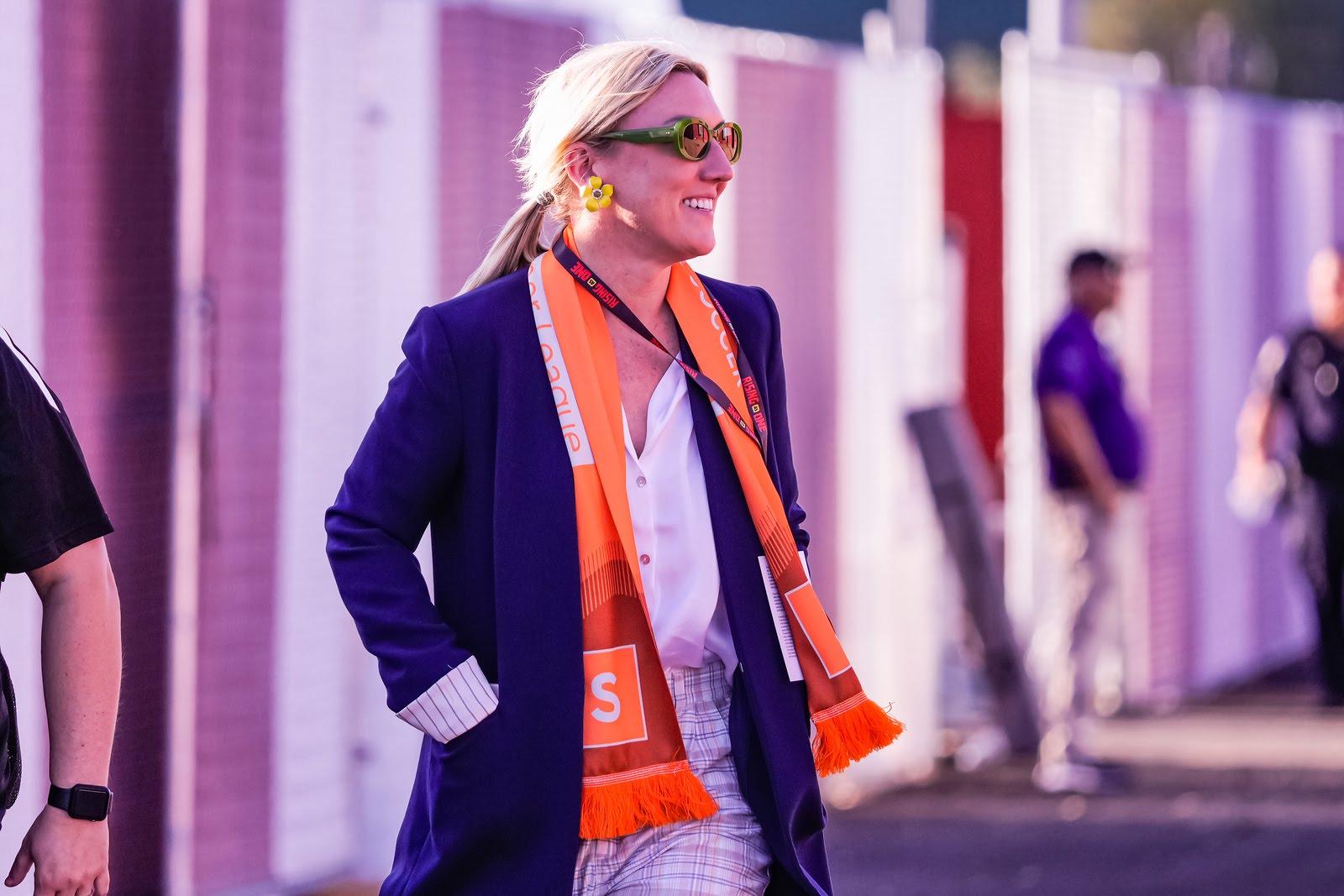
USL Super League President Amanda Vandervort visits the Phoenix Rising Stadium on May 26. Phoenix Rising is one of two Arizona franchises in the new professional Super League that will start in the fall of 2023. Photo by Arianna Grainey, courtesy Phoenix Rising FC.
- Lastly the most important question is: Will the Super League sanctioning be approved by U.S. Soccer? Looking at the history of competing league efforts in the U.S., as well as in many countries around the world, such as France, England, Italy, etc.—for both men and women—there is only one pro league. If U.S. Soccer is reticent to grant the Super League sanctioning at the top level, there could be a nuclear battle coming and even potentially a law suit on federal restraint of trade—at the very worst FIFA could decertify the Super League, but how is that possible when the USL has over 100 men's teams and 65 women's teams in other divisions under their umbrella—we sincerely hope this does not happen for the sake of the women's game and soccer in general. Women's soccer is growing so it is a good time to launch this league but, if U.S. Soccer approves it, will it end up being effectively a Division 1A loop below the full Division 1 NWSL or will it be given Division 2 sanctioning? On social media, one person said: "Why on earth would the governing body of a sport sanction two Division I leagues in a sport in the same country? It makes absolutely no sense whatsoever. As if U.S. Soccer didn't already have enough credibility problems for its treatment of the women's game. What a joke."
Ryan Harnetiaux of the Spokane effort (which again is also putting a team in the W League and men's League 1 for next year when their new downtown stadium will be completed) gave a very reasoned and coherent response to my question on the sanctioning issue, which should alleviate a lot of fears that the Super League is trying to damage the NWSL: "My understanding is, and I am not speaking on behalf of the USL or Amanda Vandervort, that Division 1 sanctioning from the U.S. Soccer Federation is a fairly binary process. If you meet the qualifications that are laid out, I believe that sanctioning is given.
"Super League wants to be Division I because the owners and USL want it that way and the owners are putting large amounts of investments into new stadiums across the country to be able to be eligible to be considered for this league. Anytime you create something that has to live up to the highest standards in the field, [this] is a good thing. That's my theory on it. Women deserve it. …We shouldn't have to see people leave the United States to play professional soccer, potentially even in front of a home town audience. We would have done Super League if it were Division 2. There is a higher cost associated with running the league as a Division 1 league but we believe that the benefits are worth it."
To emphasize his point, the club has allocated $4 million to stadium improvements, including upgrading lights for ESPN's streaming requirements and for the artificial turf field. Harnetiaux said that the stadium was designed to accommodate a future second deck on one side, which would expand the capacity to 8,500 at a minimum. The artificial field is necessary as the stadium will also host high school American football and soccer games for five local public schools, replacing Albi Stadium, which was built in 1950 and had capacity of up to 35,000 people for years. Located in the extreme northwest of the city, it was always an albatross, particularly for soccer, as it had a huge crown in the middle of an astroturf field for drainage purposes. One professional player who played on the field for an NASL exhibition match in the mid-1970's, remembered that it was: "like playing on a hill."
This reporter liked Ryan Harnetiaux's mention that he was not speaking for Amanda Vandervort, so two days later, TribalFootball.com met with her at a Phoenix Rising game on May 26, as she was promoting her new league in the State—she is a native of Tucson. I asked her if she saw any barriers to receiving Division I status from U.S. Soccer and she replied: "We have been very deliberate in our process to arrive where we are today in our attentions to be a Division I league. We've been in constant communication with U.S. Soccer and they have been really supportive all along the way."
U.S. Soccer was a major funding benefactor in the launch of the NWSL but it really has to act neutrally in this case, and if the USL meets the Division I standards—which they appear to—then Division 1 status should be granted to the Super League. Our verdict is that the USL Super League is being very creative with its move to a fall-spring season and the effort to gain Division I status. We see two vastly different philosophies between the USL and NWSL and that the Super League is not vying to merge with or put the NWSL out of business. This is an effort to grow the landscape of professional women's soccer in the U.S. and U.S. Soccer should give the Super League teams Division I sanctioning and encourage their efforts. It wasn't too long ago that I had to drive two hours from Toledo, Ohio to Goshen, Indiana to see professional women's soccer in the interim periods between the WUSA and WPS and then WPS and the NWSL. Players wanted to play professionally but had very few opportunities. This is a tremendously positive and groundbreaking effort for the game that should be encouraged.
Other Professional Women's Leagues in the Works
WISL
Besides the USL's Super League, there are two other leagues that are planning to launch professional leagues over the next year or two, with a few other possible efforts in the planning phase. WISL, which came out of the National Independent Soccer Association (NISA)—a Division 2 men's league which began play in the 2019-20 season—has had some stability issues with teams (a local franchise in Phoenix was shut down last year because the team staff was spending money without the owners' approval and then ran afoul of government rules on visas to players).
However, now the Women's Independent Soccer League (WISL) women's offshoot is run by Lynn Berling-Manuel, who was the Publisher of Soccer America for many years, which her father started in the early 70's. Berling-Manuel was also the CEO of United Soccer Coaches (national coaching association) and she is one of the true visionaries of American soccer who always has the best interest of the game as top priority.
She recently said that that there is interest in European teams investing in minor league soccer in the States: "I'd say Europe, they're looking at it very seriously Quite frankly, I've been surprised by the interest out of Europe—everybody's intrigued, just like they've been on the men's side. We are all intrigued (by) the amount of talent in this country. And quite honestly, there are very, very, very few outlets for that talent."
The WISL is scheduled to start play in 2024 as a Division 2 professional league. NISA originally was going to partner with the UWS for a pro league but that broke down in early 2021.
Not surprising given her background with coaches, Berling Manual told The Athletic: "We would love to see all of our coaches be women. There are far too few women coaches at a high level in this country. They've made it daunting in terms of its expense. There's a lot of barriers that are very significant. They've tried to fix that, but I think that's really tough. And so, we would be hopeful that, if not head coaches, we want to make sure that your coaches and specialty coaches, other positions, are as much women-focused as possible."
WPSL Pro
WPSL, which is the largest professional women's league in the world with 128 teams in the amateur league for 2023, has said that they are going pro in 2025 but as Division 3 League with 10 teams. However one head coach in the league told me: "That's as likely as Vanuatu becoming a nuclear power" because he didn't think there were enough current WPSL owners who could afford the financial expense to move up (For more on the League's plans see: The Week in Women's Football: NWSL (P3) preview - Spirit Rodman bobblehead; Ex-Spurs coach Amoros at Gotham - Tribal Football). To be fair to the WPSL, the league started the 7 team WPSL Elite as a higher-level professional league in 2012 as a "gap year" after the WPS folded in 2011 and before the NWSL launched in 2013; I covered that league closely and would call it more of a semi-professional endeavor, though it did keep a number of players employed, including some who would win the Women's World Cup with the U.S. a few years later (in 2015) in Canada. We will keep readers apprised of this effort as we receive more news.
Other Leagues
UWS, along with the W League, is certainly top of the tier for organizational ability and structure and has two amateur divisions: UWS-1 (40 teams for 2023) and UWS League 2 (25 teams in 2023)—the latter is a younger, developmental league. The UWS is poised to add the Professional Division 3 level but Commissioner Joe Ferrara Jr. has said that they are not making this addition at the present time. The UWS team budgets are typically in the $40,000 to $100,000 level at the amateur level.
The professional Division 3 level operating budgets are projected to be in the $800,000 to $1.2 million range, with the additional travel, player and coaches' salaries and more front office staff expenses. The U.S. Soccer requirements for a Division 3 league (see Division 1 and 2 requirements above) include having a principal owner (with at least 35% shares) who has a $5 million portfolio at a minimum. Teams must also play in a venue which holds at least 1,000 fans and the league must have 6 teams, which shouldn't be a problem long-term from their current base of UWS member teams.
MLS Next Pro has talked about possibly expanding into the women's side at the Division 3 level but this seems more of an exploratory effort right now (see: The Week in Women's Football: NWSL (P3) preview - Spirit Rodman bobblehead; Ex-Spurs coach Amoros at Gotham - Tribal Football).
In Canada, their professional league effort has three teams currently and wants to launch with eight in 2025. It would be a top league in Canada but many would see it as Division 2, as most of the top Canadian players are contracted to NWSL or European sides.
There has been some talk about the women's indoor league—the National Indoor Soccer League—perhaps expanding to an outdoor season as well, but right now there are only four teams which completed years 1 and 2 and the franchises are only in the Southeastern U.S. while U.S. Soccer professional accreditation dictates a multi-region or national footprint.
USL Girl's Academy
The USL recently announced the first-ever USL Academy Girls divisions, laying the foundation of the women's developmental pathway, following the announcement of the initial markets of the USL Super League (see above). Amanda Vandervort, USL Super League President, who oversees the women's pathway, said: "We are thrilled to launch the USL Academy Girls divisions this summer. The foundation of the USL women's pathway is just as vital as the top, and as that pathway continues to grow and expand, the Academy will develop a strong and sustainable player pool for professional women's soccer."
There will be 36 women's clubs (see below). On the men's side, which began in 2021, the USL Academy League provides clubs in all three of the USL's professional divisions with an elite youth development and competition platform to develop local players for their senior teams.
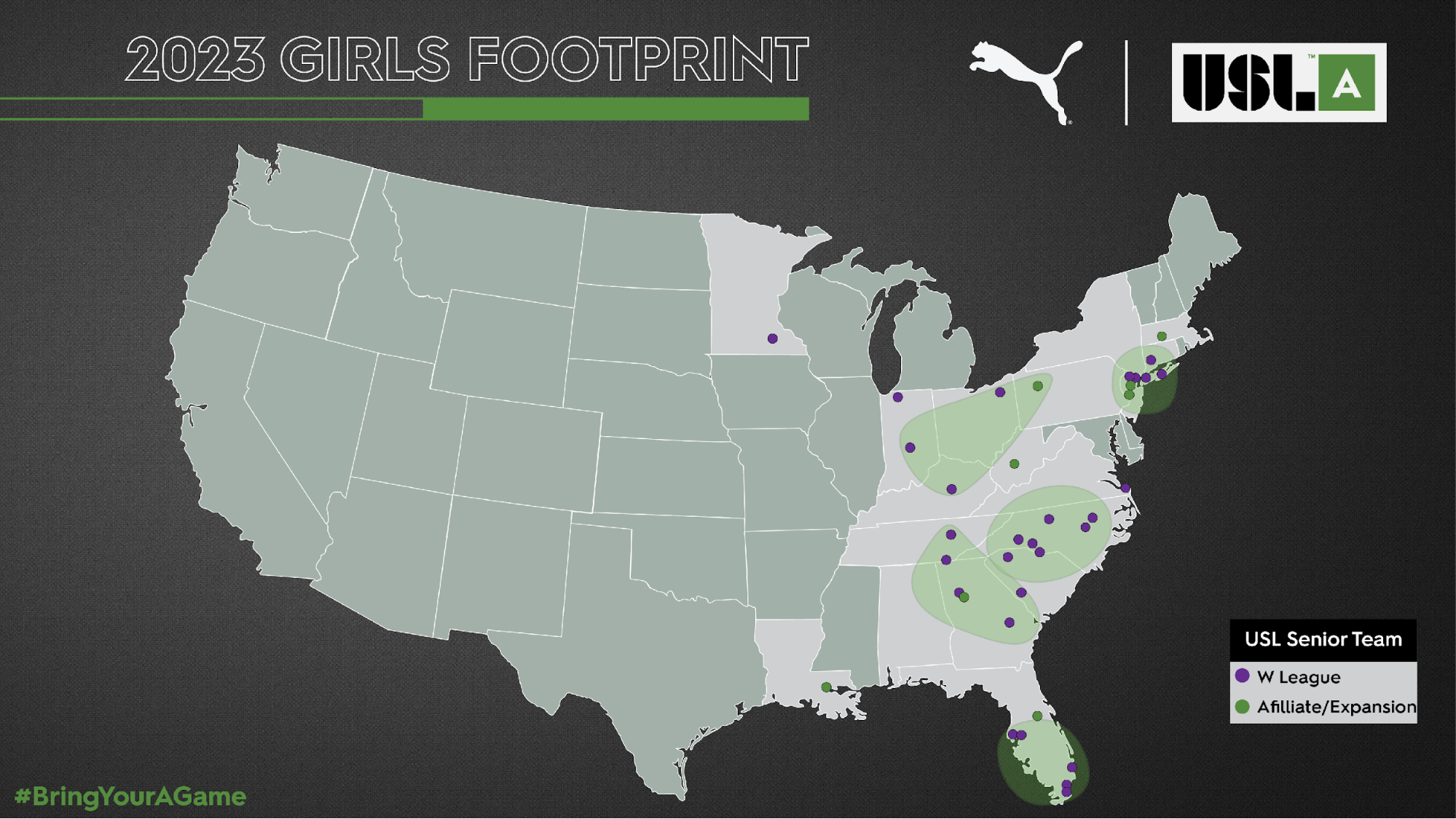
2023 GIRLS USL ACADEMY LEAGUE
Metro Division (6): AC Connecticut, FC Copa Academy, Long Island Rough Riders, Manhattan SC, Morris Elite, Paisley Athletic
Southeast Division (5): FC Miami City, Miami Athletic Club, Palm City Americanas, Swan City, Tampa Bay United
Valley Division (4): Cleveland Force, Indy Eleven, Lexington Sporting Club, Pittsburgh Riverhounds SC
South Atlantic Division (6): Asheville City, Charlotte Independence, FC Carolinas, NC Fusion, NCFC Youth/NC Courage, Wake FC
South Central Division (6): Chattanooga Red Wolves SC, East Atlanta FC, One Knox, SC United Bantams, South Georgia Tormenta FC, Southern Soccer Academy
Tim Grainey is a contributor to Tribal Football. His latest book Beyond Bend it Like Beckham is on the global game of women's football. Get your copy today.
Follow Tim on Twitter: @TimGrainey

